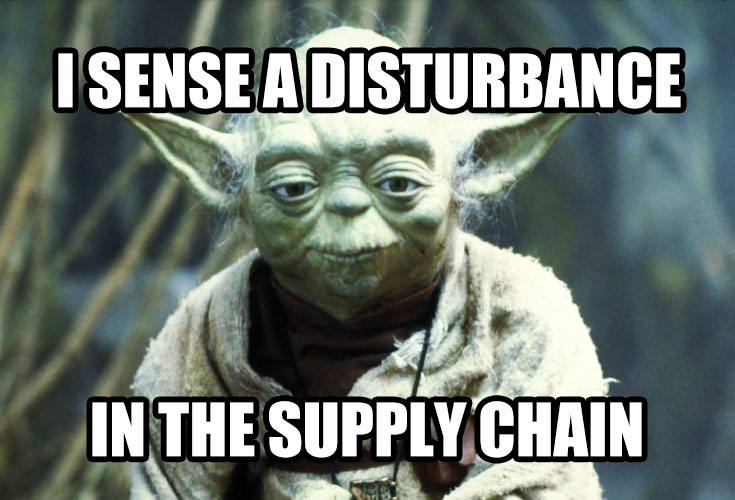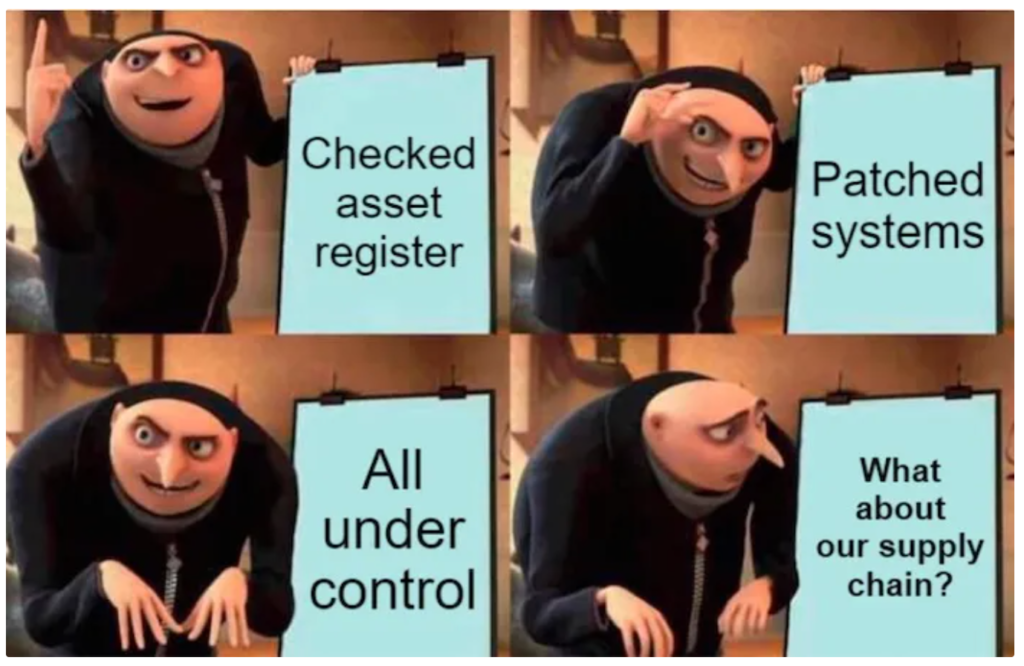Supply Chain Risk Management for Web: The Most Complete Guide

In the ever-evolving digital landscape of our age, websites have become pivotal in connecting businesses with their audiences. As online platforms continue to grow in importance, the intricacies of supply chain risk management in websites are gaining prominence. The term “supply chain risk management” encompasses a range of challenges and uncertainties that can impact the functionality, security, and reliability of websites.
In this article, we will explore the various dimensions of supply chain risk management in websites and delve into effective strategies to mitigate potential threats.
Understanding Supply Chain Risk Management in Websites
Components of Website Supply Chain
At its core, the supply chain for websites involves a complex network of interconnected components. These components can include web hosting services, content delivery networks (CDNs), third-party plugins, and various scripts that enhance website functionality. Each of these elements introduces its own set of risks, from data breaches to performance issues and even legal liabilities.
Cybersecurity Threats
One of the primary concerns in website supply chain risk management is cybersecurity. As websites rely on multiple third-party services, any vulnerability in these services can be exploited by malicious actors. Cybersecurity threats such as data breaches, malware injections, and DDoS attacks pose a significant risk to the overall integrity of websites and the sensitive information they handle.
Dependency on Third-Party Services
Many websites depend on third-party services for various functionalities, such as analytics, payment processing, and social media integration. While these services enhance user experience and provide valuable insights, they also introduce dependencies that can lead to disruptions if not managed properly. Supply chain risk management in websites involves assessing the reliability and security of these third-party services.
Privacy and Legal Risks
Websites must adhere to various legal and regulatory requirements, depending on the industry and geographical location. Failure to comply with these regulations can result in severe consequences, including legal actions and reputational damage. Ensuring compliance and managing legal risks are integral aspects of effective supply chain risk management for websites.
Supply Chain Risk Management: Key Concepts
Supply chain risk management in websites involves a set of key concepts and strategies aimed at identifying, assessing, and mitigating risks that could impact the functionality, security, and reliability of online platforms. Here are the key concepts of supply chain risk management specifically tailored to websites:
Dependency Mapping:
Concept: Understanding and visualizing the interdependencies between various components of the website’s supply chain, including web hosting, third-party plugins, content delivery networks (CDNs), and external services.
Importance: Helps businesses identify critical dependencies and potential points of failure, enabling proactive risk mitigation.
Third-Party Risk Assessment:
Concept: Evaluating the security, reliability, and compliance of third-party services and components integrated into the website, such as payment processors, analytics tools, and APIs.
Importance: Ensures that third-party services do not introduce vulnerabilities or compromise the integrity of the website.
Continuous Monitoring:
Concept: Implementing real-time monitoring mechanisms to track the performance, security, and compliance of the website and its supply chain components.
Importance: Enables early detection of potential risks, security incidents, or performance issues, allowing for prompt intervention and mitigation.
Cybersecurity Protocols and Best Practices:
Concept: Implementing and adhering to robust cybersecurity protocols, including encryption, firewalls, regular security audits, and best practices to protect against cyber threats.
Importance: Enhances the website’s resilience against data breaches, malware, and other cybersecurity risks.
Compliance Management:
Concept: Ensuring that the website adheres to relevant legal and regulatory requirements, industry standards, and data protection regulations.
Importance: Mitigates legal and compliance risks, preventing potential legal actions, fines, and reputational damage.
Redundancy and Contingency Planning:
Concept: Building redundancy into the website’s infrastructure, data storage, and critical functionalities to minimize the impact of disruptions and downtime.
Importance: Improves the website’s resilience by providing backup systems and contingency plans to maintain continuity in the face of failures.
Supplier Relationship Management:
Concept: Establishing and maintaining strong relationships with suppliers, hosting providers, and third-party service providers to ensure transparency, communication, and collaboration.
Importance: Fosters a collaborative environment, allowing businesses to work closely with suppliers to address potential risks and vulnerabilities.
Data Privacy and User Security:
Concept: Prioritizing the protection of user data through secure data storage, encryption, and adherence to privacy regulations.
Importance: Upholds user trust, prevents data breaches, and mitigates the risk of reputational damage associated with privacy and security incidents.
Incident Response Planning:
Concept: Developing and implementing plans and procedures to respond effectively to security incidents or disruptions in the website’s supply chain.
Importance: Minimizes the impact of incidents by facilitating a structured and coordinated response to security breaches or other disruptions.
Performance Optimization:
Concept: Balancing the integration of third-party components with the optimization of website performance to ensure a seamless user experience.
Importance: Addresses the challenge of maintaining performance while leveraging external services, preventing slow load times and user dissatisfaction.
By integrating these key concepts into their supply chain risk management strategies, businesses can enhance the resilience and security of their websites, ensuring a positive user experience and safeguarding their digital assets.

Examples of Supply Chain Risks in Websites
Supply chain risks in websites can manifest in various forms, impacting the functionality, security, and reliability of online platforms. Here are some examples of supply chain risks in websites:
- Third-Party Service Vulnerabilities:
- Example: A website relies on a third-party payment processing service. If that service experiences a security breach, the website’s financial transactions and user data may be compromised.
- Dependency on External APIs:
- Example: A website heavily depends on external APIs for functionalities such as weather updates, maps, or social media integration. If one of these APIs experiences downtime or is discontinued, it can disrupt the website’s features and user experience.
- Unsecured Content Delivery Networks (CDNs):
- Example: A website uses a CDN to optimize content delivery and improve load times. If the CDN is not properly secured, it becomes vulnerable to DDoS attacks, leading to downtime and degraded performance for the website.
- Supply Chain Disruptions:
- Example: A website’s hosting provider experiences technical issues, leading to downtime for the hosted websites. This disruption can have a cascading effect, affecting multiple websites relying on the same hosting service.
- Outdated Software and Plugins:
- Example: A website uses outdated plugins or content management system (CMS) software. These outdated components may have known vulnerabilities that could be exploited by hackers to gain unauthorized access or inject malicious code.
- Data Breaches Through Third-Party Integrations:
- Example: A website integrates with various third-party services for user authentication, analytics, and advertising. If any of these services experience a data breach, it could compromise the personal information of the website’s users.
- Legal and Compliance Risks:
- Example: A website operates in an industry subject to specific regulations, such as healthcare or finance. Failure to comply with these regulations may result in legal actions, fines, and reputational damage.
- Inadequate Supplier Security Measures:
- Example: A website relies on a cloud service provider for hosting. If the cloud provider does not have robust security measures in place, it increases the risk of unauthorized access, data breaches, or service disruptions.
- Insufficient Monitoring and Incident Response:
- Example: A website lacks effective monitoring tools to detect and respond to security incidents in real-time. This leaves the website vulnerable to prolonged cyberattacks, increasing the potential damage.
- Lack of Redundancy:
- Example: A website has a single point of failure in its supply chain, such as a sole hosting provider. If that provider experiences an outage, the website goes offline, resulting in lost revenue and damage to the brand’s reputation.
Understanding and addressing these supply chain risks is essential for businesses to maintain a resilient and secure online presence. Proactive risk management strategies, continuous monitoring, and the adoption of secure technologies can help mitigate these potential threats.
Strategies for Effective Website Supply Chain Risk Management
Risk Assessment and Mapping
The first step in supply chain risk management for websites is conducting a comprehensive risk assessment. This involves identifying and understanding the various components and dependencies within the website’s supply chain. By mapping out the supply chain, businesses can gain insights into potential vulnerabilities and prioritize risk mitigation strategies.
Continuous Monitoring and Evaluation
Given the dynamic nature of the digital landscape, continuous monitoring is crucial for effective supply chain risk management in websites. Regularly evaluating the performance, security, and compliance of all components in the supply chain allows businesses to proactively address emerging threats and adapt their strategies accordingly.
Supplier Relationship Management
Establishing strong relationships with suppliers and third-party service providers is fundamental to mitigating risks in the website supply chain. Communication, transparency, and collaboration are key elements of supplier relationship management. Businesses should conduct thorough due diligence when selecting and onboarding suppliers, ensuring they meet the required security and compliance standards.
Cybersecurity Protocols and Best Practices
Implementing robust cybersecurity protocols and best practices is essential in safeguarding websites against cyber threats. This includes regular security audits, encryption of sensitive data, and the implementation of firewalls and intrusion detection systems. Businesses should also stay informed about the latest cybersecurity trends and continuously update their security measures.
Redundancy and Contingency Planning
Building redundancy into the website supply chain can help mitigate the impact of disruptions. This involves having backup systems and contingency plans in place to ensure continuity of operations in the event of a failure or outage. Redundancy can be applied to hosting services, data storage, and critical functionalities to minimize downtime and maintain user trust.

Supply Chain Risk Management: How Reflectiz Can Help
In the realm of supply chain risk management for websites, specialized tools and platforms can provide valuable support. Reflectiz, a leading solution in this space, offers a range of features designed to enhance the security and reliability of websites.
Third-Party Risk Assessment
Reflectiz conducts comprehensive assessments of third-party components within a website’s supply chain. By continuously monitoring and analyzing the behavior of these components, Reflectiz identifies potential vulnerabilities and risks. This proactive approach allows businesses to address issues before they escalate, ensuring the integrity of the website’s supply chain.
Continuous Monitoring
Reflectiz provides real-time monitoring of website components, alerting businesses to any suspicious or malicious activity. This capability is crucial in detecting and responding to cybersecurity threats promptly. By leveraging advanced threat intelligence, Reflectiz enhances the security posture of websites and minimizes the risk of data breaches and other cyberattacks.
Compliance Management
Ensuring compliance with industry regulations and standards is simplified with Reflectiz. The platform helps businesses track and manage compliance requirements, reducing the risk of legal issues and regulatory penalties. By staying up-to-date on compliance obligations, websites can maintain trust with users and stakeholders.
Dependency Mapping and Visualization
Reflectiz offers a visual representation of the entire website supply chain, including dependencies on third-party services. This mapping helps businesses understand the intricate relationships between components and identify potential points of failure. By visualizing the supply chain, organizations can make informed decisions to strengthen resilience and reduce vulnerabilities.
Conclusion
In the digital era, supply chain risk management is a critical aspect of maintaining the integrity, security, and reliability of websites. As businesses navigate the complexities of the online landscape, understanding and addressing the risks associated with the website supply chain are paramount. By implementing proactive strategies, leveraging advanced tools like Reflectiz, and staying vigilant in the face of emerging threats, businesses can safeguard their online presence and build trust with users and stakeholders alike.
Supply Chain Risk Management: FAQs
What is web supply chain risk management?
Web supply chain risk management involves identifying, assessing, and mitigating potential risks associated with the various components, dependencies, and third-party services that make up the supply chain of a website. It aims to ensure the security, reliability, and continuity of a website’s operations by proactively addressing vulnerabilities and potential points of failure.
What damage can a web supply chain attack create?
A web supply chain attack can result in severe damage, including data breaches, service disruptions, and reputational harm. Attackers may exploit vulnerabilities in third-party services, components, or dependencies to gain unauthorized access, inject malicious code, or disrupt website functionality. The consequences can include the loss of sensitive data, financial losses, downtime, and a significant impact on user trust and confidence in the affected website or business.
How can you protect against a web supply chain attack?
Protecting against web supply chain attacks involves a multifaceted approach. Conduct thorough risk assessments and map the supply chain to identify vulnerabilities. Regularly evaluate the security of third-party services, enforcing strong access controls and authentication measures. Implement continuous monitoring using tools like SIEM to detect and respond to potential threats promptly. Follow cybersecurity best practices, such as regular audits, encryption, and software updates. Develop an incident response plan, maintain data backups, and ensure redundancy for critical systems. Foster strong relationships with suppliers and prioritize user education on security awareness. Stay compliant with relevant regulations, conduct regular security training, and create a security-conscious culture. By integrating these measures, businesses can significantly enhance their resilience against web supply chain attacks.
What is the biggest supply chain attack ever?
one of the most significant and widely known supply chain attacks was the SolarWinds cyberattack. Discovered in December 2020, it targeted SolarWinds, a prominent IT management software provider. The attackers compromised SolarWinds’ software development process, injecting malicious code into its Orion software updates. This breach allowed the attackers, believed to be a Russian-backed group, to infiltrate numerous organizations and government agencies, including major U.S. government departments and private companies. The scale and sophistication of the SolarWinds attack highlighted the vulnerabilities within complex supply chains, emphasizing the importance of robust cybersecurity measures throughout the software development and distribution process. Keep in mind that more recent developments may have occurred since my last update.
Subscribe to our newsletter
Stay updated with the latest news, articles, and insights from Reflectiz.
Your Website looks great!
But what’s happening behind the scenes?
Discover your website blind spots and vulnerabilities before it’s too late!







